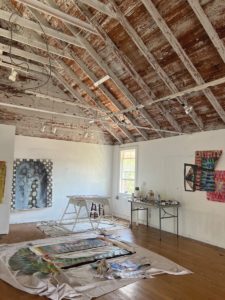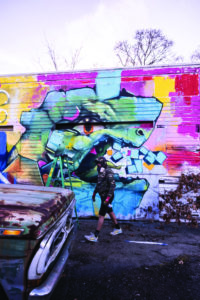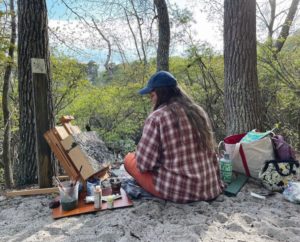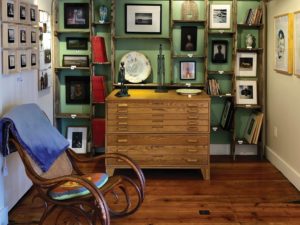Paige Beeber had been cloistered in New York City for months recovering from Covid when she had the opportunity to spend three July weeks on the Outer Cape. “Being able to bike to the dunes was good for my mental and physical health,” she said.

Beeber was the beneficiary of a summer residency sponsored by Nick Lawrence, one of four Outer Cape gallerists who created similar opportunities for artists this year. As a participant in Lawrence’s DNA Residency, Beeber was able to revitalize her art practice. “Life is slow here, but I’m also speeding up the progress of my work,” she said while working on a series of paintings in a spacious studio above the Provincetown Tennis Club. “Real estate is crazy in New York City. As artists, our biggest struggle is finding space to present work on a large scale.”
Freight + Volume and DNA
Historically, the Outer Cape has been a destination for artists looking for a place where leisure, work, and a sense of community mix to create a culture conducive to incubating ideas and creating new work. But, as in New York, real estate costs have skyrocketed.
Beeber’s summer opportunity in Provincetown was facilitated by Lawrence in tandem with his New York-based gallery Freight + Volume. Lawrence and a handful of others are seeking to address the dearth of opportunities for artists by creating residencies that subsidize the cost of working on the Outer Cape, at least for a short time.
“If it weren’t for this residency, I don’t think I would have had the opportunity to make it here,” said Beeber. Moreover, she said, “living in a new area and with a new group of people brings new perspective — a benefit for any artist.”
For his part, Lawrence seeks to bring in contemporary artists he says wouldn’t otherwise think of the Cape as a place to come and work. It has other benefits, too. “They tell friends about Provincetown; they go to shows and museums,” he said. “It keeps the creative juices flowing.”
The space used for the DNA residency was once the studio of the late Tony Vevers. Lawrence has a long-term lease on the 2,000-square-foot space; he ran DNA Gallery there from 1994 to 2011. Eventually he thought it was better suited for a residency because of its “beautiful light and open space.” In addition to a studio to work in, artists receive housing in Provincetown or Eastham.
Lawrence has typically limited the residency to artists connected to his gallery. This past season, which ran from May through October, the residency hosted 20 artists who stayed for anywhere from one week to one month in exchange for donating a piece of their artwork.
“I’m a painter as well,” said Lawrence, who divides his time between Eastham and New York. “I thought of ways to keep the community around me by offering this residency. It’s a sharing of ideas, art, stories, and congenial dinners.”
Rugosa Gallery
At Rugosa Gallery in Eastham, Joey Rugo is also trying to nurture the arts on the Outer Cape by supporting a residency connected to a gallery. In his case, however, the residency came first.
Rugo, 34, owns three businesses in Eastham: a restaurant (Joey’s Joint), the Rugosa Inn, and the recently opened Rugosa Gallery. When Boston-based artist Adam O’Day needed a place to stay, he bartered artwork for a room at Rugo’s inn. Rugo began building relationships with other artists, continuing to barter artwork for rooms — and building a collection along the way.

O’Day later suggested the idea of an artist residency to Rugo, who wasn’t familiar with the concept. But he had previously worked at Kripalu Yoga Center in Stockbridge, where “they did a lot of different workshops for yoga, meditation, and writing,” he said. “That was always my plan with the hotel, but I put it on the shelf.” An artist residency allowed him to revisit the idea of creating a community-based experience. Rugo and O’Day organized the first week-long residency in spring 2021. It has now turned into an annual event.
“We want 10 to 15 artists to come and take over all the rooms at the inn,” said Rugo. “Art is an isolating career path sometimes. So, a big component of the residency is creating a community and getting artists together to share experiences.”
During the residencies, artists have participated in plein air outings, figure drawing sessions, and public art projects. Rugo also organized visits to the studios of painter Ann Packard and printmaker Vladimir Schuster. But the program is about more than just improving skills. “I wanted to give more amateur artists that are on the brink of making a leap some confidence to do it more full-time,” said Rugo. “Sometimes, it’s just meeting people in the position you want to be and realizing they’re not that different.”
Rugo said he charged residents $100 for food but nothing for lodging or workshops. He added that he needs to reconsider the financing of the program and possibly look for sponsors or charge the participants more. “I could charge people up to $2,000,” he said. “But it would probably be people on an art vacation rather than serious artists.” In the meantime, the resident artists have been showing their work, often inspired by graffiti or street art, at his gallery.
“With two years of the residency, I have relationships with 30 or 40 artists,” said Rugo. “We’re bringing some really talented artists to a community where artists are getting financially chased away.” Rugo mentioned Gris One, a Columbian street artist who participated in the residency and showed work at the gallery this summer. Normally, Rugo said, “someone like this would never come to this area to do public art.”
“I feel like I’m friends with the people that stayed with me and that I’m representing,” said Rugo. “It’s not a random connection.”
Room 68
Brent Refsland and Eric Portnoy own Room 68, a pair of galleries in Wellfleet and Provincetown, and have also built relationships with the artists they represent through an informal residency program. Since 2016, they have offered living space and access to their Provincetown gallery, which doubles as a work studio in the off season. The residents do not pay a fee.

Emily Wilker met Refsland when she was completing her M.F.A. at the Rhode Island School of Design in 2021. That summer, she exhibited a series of rich landscape paintings at Room 68’s Wellfleet gallery. This year, the gallery invited her to stay in Provincetown for a week in May.
Unlike many of the other contemporary artists brought to the Cape through gallery residency programs, Wilker was already working in a tradition deeply rooted in the culture of the Outer Cape. “I’m a plein air painter, and being outside is integral to my practice,” she said. One day during the residency, Refsland dropped Wilker off at a pond in Wellfleet to work for six hours. Rather than looking at the water, Wilker looked at the ground, capturing its textures in a painting where natural elements are rendered thickly in three-dimensional strokes of paint.
“It started off with bringing artists in the spring,” said Refsland. “We’re celebrating art making in Provincetown and the Cape and introducing people to the magic that happens here.”
Land’s End Gallery and Books
Down toward the East End of Commercial Street in Provincetown, Mischa Richter is also motivated to bring artists to the Outer Cape. “Young artists need to be able to come here and produce art,” he said. “We have to help facilitate that.”

Richter, whose family comprises several generations of Provincetown artists, is a photographer and filmmaker; his film I Am a Town presents a portrait of a place charmed by misfits and creative souls. But the film is as elegiac as it is celebratory.
“We’re historically an art destination,” said Richter. “But the art world here has been trumped by tourism. It’s really pedestrian now.” Richter, who returned to live in Provincetown after a career in London and New York, has channeled his frustration — and hope — into a new venture, Land’s End Gallery and Books, which opened this summer at 437 Commercial St.
“I opened the gallery because there are artists who wanted the opportunity to show here,” said Richter, “and ones who were having trouble just being here.” One such artist this summer was Nancy Loeber, who showed a series of mixed-media portraits of women connected to Provincetown’s history. Richter enlisted the support of the Provincetown Arts Society, which runs the Mary Heaton Vorse house, and Loeber was able to stay at the Vorse house during her exhibition. It was a solution to a problem Richter has seen often: “Artists have trouble coming to their own shows or openings here.”
Richter’s venture also entails bringing artists to Provincetown in the off season to create limited-edition publications; the proceeds will pay for the production of more books the following season. (Loeber will return to Provincetown this winter to create a chapbook of her portraits.)
“Ninety percent of the people coming through the door are looking for pictures of sailboats,” said Richter. “I’m trying to shift that and sell work that isn’t so obvious.” He created a nonprofit to support the publications but is still working out how it will function alongside the for-profit gallery. “The first year was difficult for us,” he said. “We didn’t lose any money, but we didn’t make much money.”
Whatever direction the venture takes, Richter remains committed to a vision of Provincetown as a place of ambitious cultural production. “Marfa’s in the middle of nowhere, but there’s a contemporary art scene,” he said of the West Texas town that has become a mecca for artists. “Why can’t we be like a Marfa?”



